Vertical farming is a transformative approach to urban sustainability, enabling cities to produce food locally while minimizing environmental impact. By optimizing resource use and integrating advanced technologies, vertical farms enhance food security and contribute to local economies, making them a vital component of sustainable urban development.
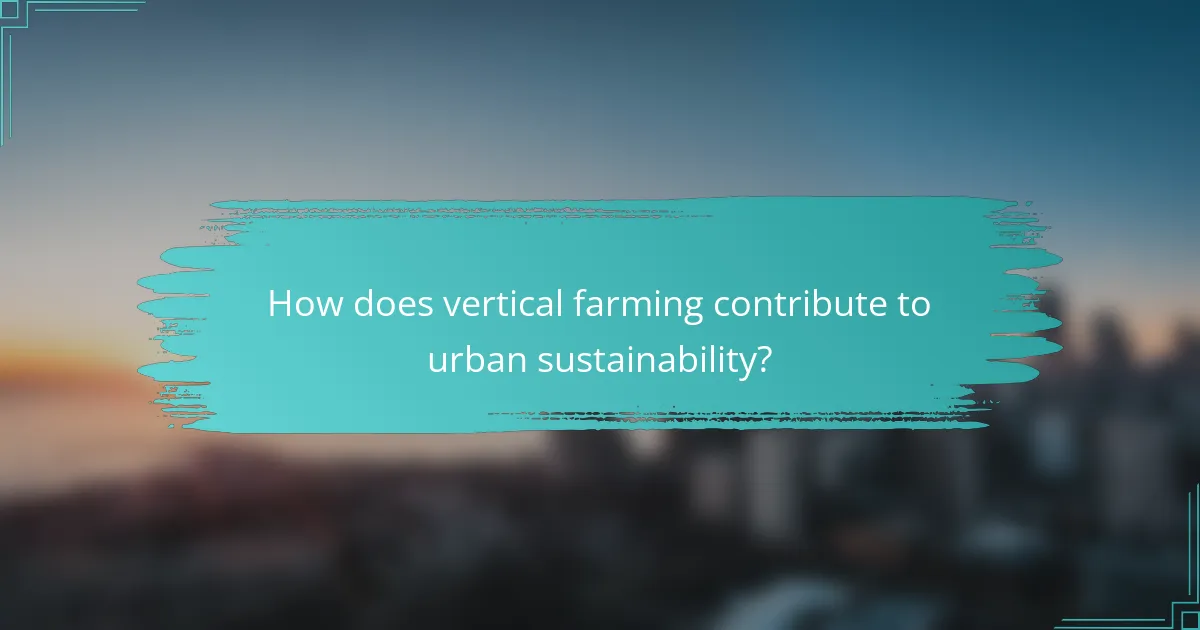
How does vertical farming contribute to urban sustainability?
Vertical farming plays a significant role in urban sustainability by optimizing resource use and reducing environmental impact. It enables cities to produce food locally, minimizing transportation emissions and promoting efficient land and water use.
Reduction of carbon footprint
Vertical farming significantly reduces the carbon footprint associated with traditional agriculture. By growing food within urban areas, it cuts down on transportation distances, which are a major source of greenhouse gas emissions.
Additionally, many vertical farms utilize renewable energy sources and energy-efficient technologies, further decreasing their overall carbon output. This shift can lead to a reduction in urban air pollution and contribute to cleaner city environments.
Conservation of water resources
Vertical farming is designed to use water more efficiently than conventional farming methods. Techniques such as hydroponics and aeroponics can reduce water usage by up to 90%, making it a sustainable option for urban areas facing water scarcity.
These systems recirculate water, ensuring that minimal waste occurs. This conservation is particularly crucial in regions where water resources are limited or under threat due to climate change.
Minimization of land use
Vertical farming maximizes food production in limited urban spaces by utilizing vertical structures. This approach allows for the cultivation of crops in a fraction of the land required by traditional farming, making it ideal for densely populated cities.
By transforming underutilized buildings or rooftops into productive agricultural spaces, vertical farms can help alleviate urban sprawl and preserve natural landscapes. This efficient land use is essential for sustainable urban development.
Promotion of local food systems
Vertical farming supports local food systems by providing fresh produce directly to urban consumers. This reduces reliance on long supply chains and enhances food security in cities.
By fostering connections between local farmers and communities, vertical farms can stimulate local economies and promote healthier eating habits. Consumers benefit from fresher produce with higher nutritional value, while farmers gain access to new markets.
Enhancement of urban biodiversity
Vertical farming can enhance urban biodiversity by creating green spaces that support various plant and animal species. These farms can serve as habitats for pollinators and other beneficial organisms, contributing to healthier ecosystems.
Incorporating diverse crops and plants within vertical farms can also promote genetic diversity, which is crucial for resilience against pests and diseases. This biodiversity can lead to more sustainable urban environments overall.
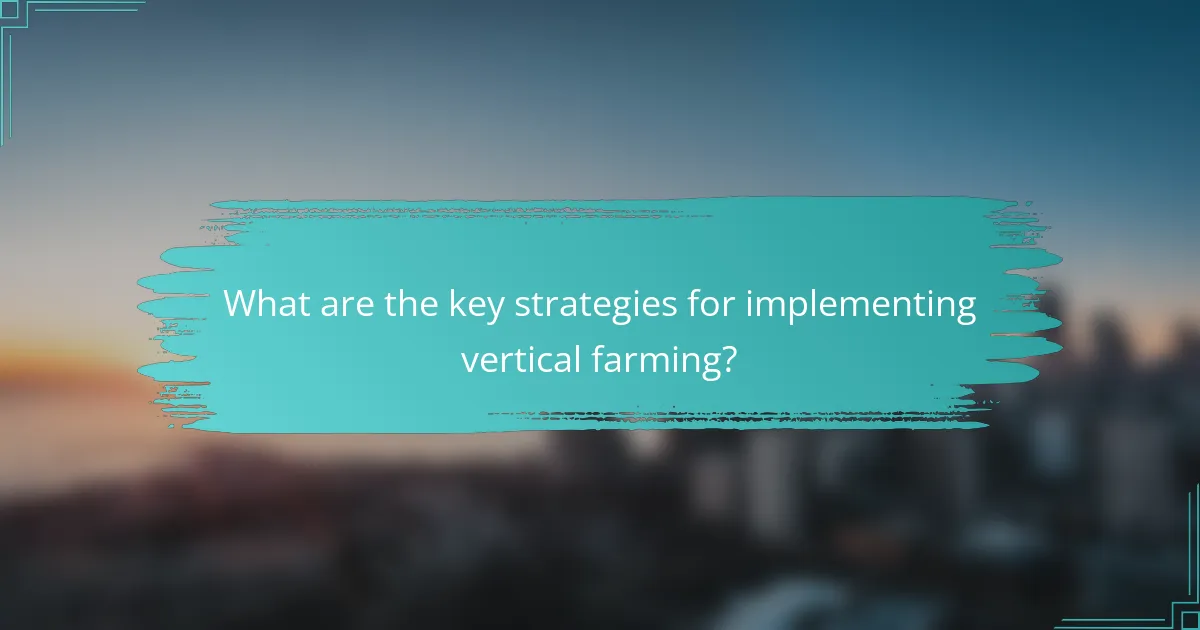
What are the key strategies for implementing vertical farming?
Key strategies for implementing vertical farming include utilizing advanced growing techniques, integrating renewable energy sources, collaborating with local governments, and adopting smart farming technologies. These approaches enhance sustainability, reduce resource consumption, and improve food security in urban areas.
Utilization of hydroponics and aeroponics
Hydroponics and aeroponics are soil-less growing methods that allow plants to thrive in nutrient-rich water or mist. Hydroponics typically involves growing plants in a nutrient solution, while aeroponics uses a fine mist to deliver nutrients directly to the roots. Both methods can significantly reduce water usage compared to traditional farming, making them ideal for urban environments.
Implementing these systems requires careful monitoring of nutrient levels and environmental conditions. Successful hydroponic and aeroponic farms often use automated systems to maintain optimal growth conditions, which can lead to faster crop cycles and higher yields.
Integration with renewable energy sources
Integrating renewable energy sources, such as solar or wind power, is crucial for making vertical farming more sustainable. By utilizing these energy sources, farms can reduce their reliance on fossil fuels and lower operational costs over time. For instance, solar panels can provide electricity for lighting and climate control systems.
When planning for renewable energy integration, consider the local climate and available resources. In sunny regions, solar energy may be particularly effective, while wind energy could be more viable in areas with consistent wind patterns.
Collaboration with local governments
Collaboration with local governments can facilitate the successful implementation of vertical farming initiatives. Governments can provide support through zoning regulations, grants, and infrastructure development. Engaging with local authorities helps ensure that vertical farms comply with urban planning and sustainability goals.
Establishing partnerships with local governments can also enhance community acceptance and promote public awareness of vertical farming benefits. This collaboration can lead to shared resources and knowledge, ultimately fostering a more supportive environment for urban agriculture.
Adoption of smart farming technologies
Smart farming technologies, such as IoT sensors and data analytics, play a vital role in optimizing vertical farming operations. These technologies enable farmers to monitor plant health, environmental conditions, and resource usage in real-time, leading to more informed decision-making and improved efficiency.
Investing in smart technologies can enhance crop yields and reduce waste. For example, automated irrigation systems can adjust water delivery based on real-time moisture levels, ensuring that plants receive the right amount of water without excess. Adopting these technologies requires an initial investment but can lead to significant long-term savings and productivity gains.
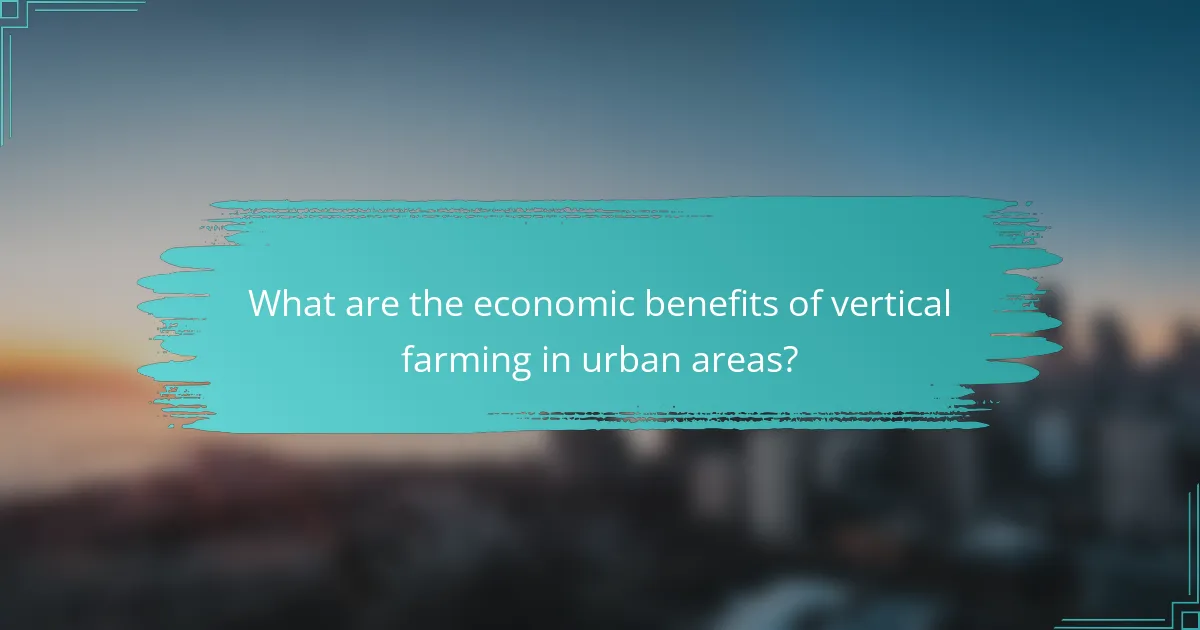
What are the economic benefits of vertical farming in urban areas?
Vertical farming in urban areas offers significant economic benefits, including job creation, reduced transportation costs, and improved access to fresh produce. These advantages contribute to local economies and enhance sustainability efforts in cities.
Job creation in urban agriculture
Vertical farming creates a variety of jobs, from agricultural technicians to logistics and marketing professionals. These positions often require different skill levels, providing opportunities for both skilled and unskilled workers.
As urban farms expand, they can stimulate local economies by increasing employment rates and supporting related industries, such as equipment manufacturing and distribution. This job growth can be particularly impactful in cities with high unemployment rates.
Reduction in transportation costs
By growing food closer to consumers, vertical farms significantly cut transportation costs. This proximity reduces fuel expenses and minimizes the carbon footprint associated with transporting produce over long distances.
In urban settings, where traditional farming is not feasible, vertical farms can supply fresh produce directly to local markets and restaurants, leading to lower prices for consumers and increased profit margins for producers.
Increased access to fresh produce
Vertical farming enhances access to fresh produce, particularly in urban food deserts where grocery stores may be scarce. By establishing farms within city limits, residents can obtain fresh fruits and vegetables without needing to travel far.
This increased availability can lead to healthier eating habits and improved nutrition for urban populations. Additionally, local sourcing can foster community engagement and support for local businesses.
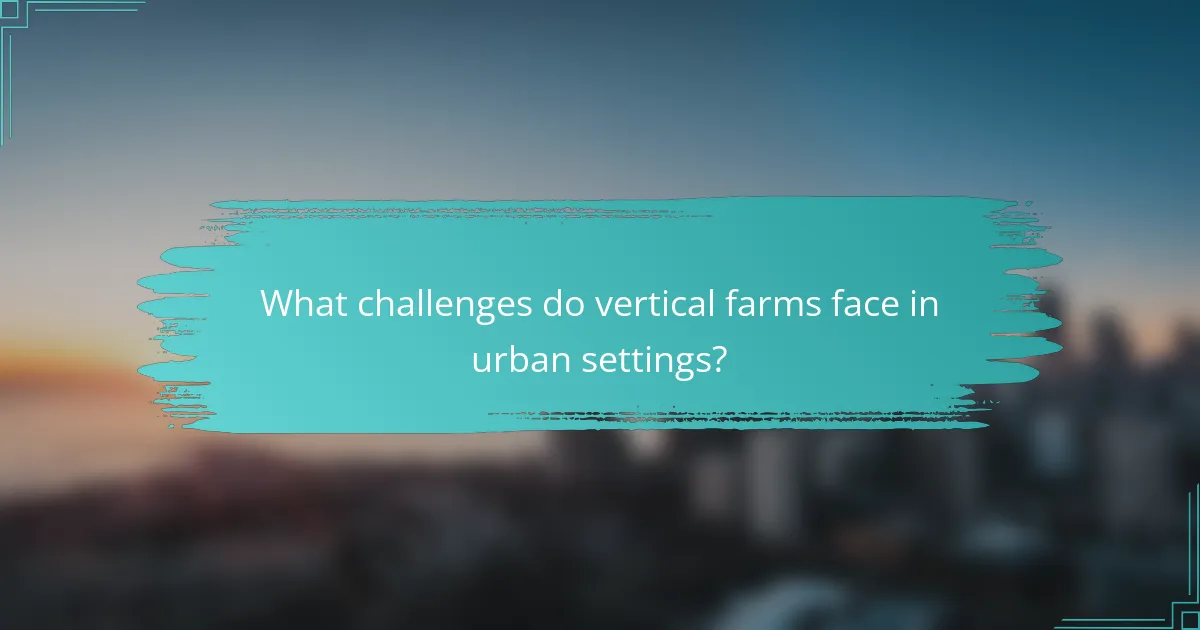
What challenges do vertical farms face in urban settings?
Vertical farms in urban areas encounter several significant challenges that can hinder their development and sustainability. Key issues include high initial investment costs, regulatory hurdles, and competition from traditional agriculture, all of which require careful consideration and strategic planning.
High initial investment costs
The establishment of vertical farms typically demands substantial upfront capital for infrastructure, technology, and equipment. Initial costs can range from hundreds of thousands to millions of USD, depending on the scale and complexity of the operation. This financial barrier can deter potential investors and operators.
To mitigate these costs, vertical farms can explore partnerships with local governments or agricultural organizations that may offer grants or subsidies. Additionally, utilizing modular systems can help reduce expenses by allowing for incremental scaling.
Regulatory hurdles
Vertical farms often face a complex web of regulations that can vary significantly by location. Zoning laws, building codes, and health regulations may impose restrictions on where and how these farms can operate. Navigating these regulations can be time-consuming and may require legal expertise.
Engaging with local authorities early in the planning process can help identify potential regulatory challenges. It is also beneficial to stay informed about any changes in local agricultural policies that could impact vertical farming operations.
Market competition with traditional agriculture
Vertical farms must compete with established traditional agriculture, which often benefits from lower production costs and established supply chains. This competition can make it difficult for vertical farms to price their products competitively, especially in markets where consumers are price-sensitive.
To differentiate themselves, vertical farms can focus on niche markets, such as organic or locally sourced produce, which may command higher prices. Building strong relationships with local retailers and consumers can also enhance market presence and loyalty.
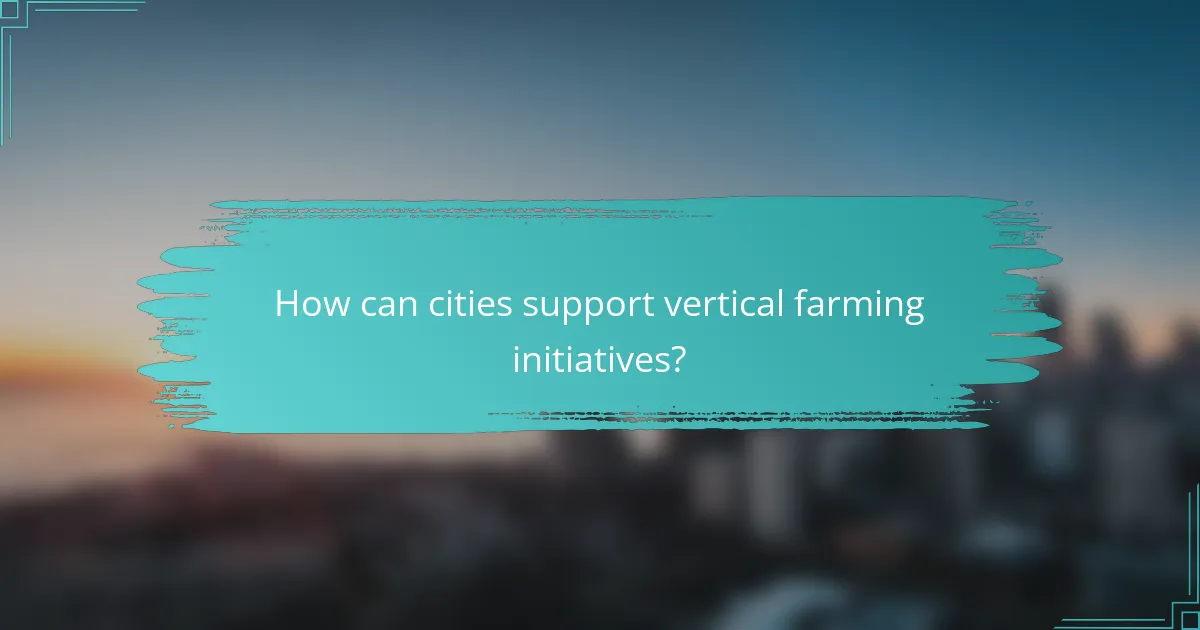
How can cities support vertical farming initiatives?
Cities can support vertical farming initiatives by implementing policies and programs that encourage investment, streamline regulations, and foster community involvement. These strategies can enhance urban sustainability and food security while promoting local economies.
Providing financial incentives
Financial incentives can significantly boost vertical farming projects by reducing initial investment barriers. Cities can offer grants, low-interest loans, or tax breaks to encourage entrepreneurs and businesses to establish vertical farms.
For example, a city might provide a 20% tax credit for the first five years of operation for new vertical farms. This not only attracts investment but also helps ensure the long-term viability of these initiatives.
Establishing supportive zoning laws
Supportive zoning laws are crucial for the successful integration of vertical farms into urban landscapes. Cities should revise zoning regulations to allow vertical farming in various districts, including residential and commercial areas.
Creating specific zoning categories for vertical farms can simplify the permitting process and encourage more projects. For instance, a city could designate certain industrial zones as suitable for agricultural use, facilitating the establishment of vertical farms.
Facilitating community engagement
Community engagement plays a vital role in the success of vertical farming initiatives. Cities can organize workshops, public forums, and educational programs to inform residents about the benefits of vertical farming and how they can participate.
Involving local communities in decision-making processes can lead to greater acceptance and support for vertical farms. Cities might also consider partnerships with schools and local organizations to create community gardens that incorporate vertical farming techniques, fostering a sense of ownership and collaboration.
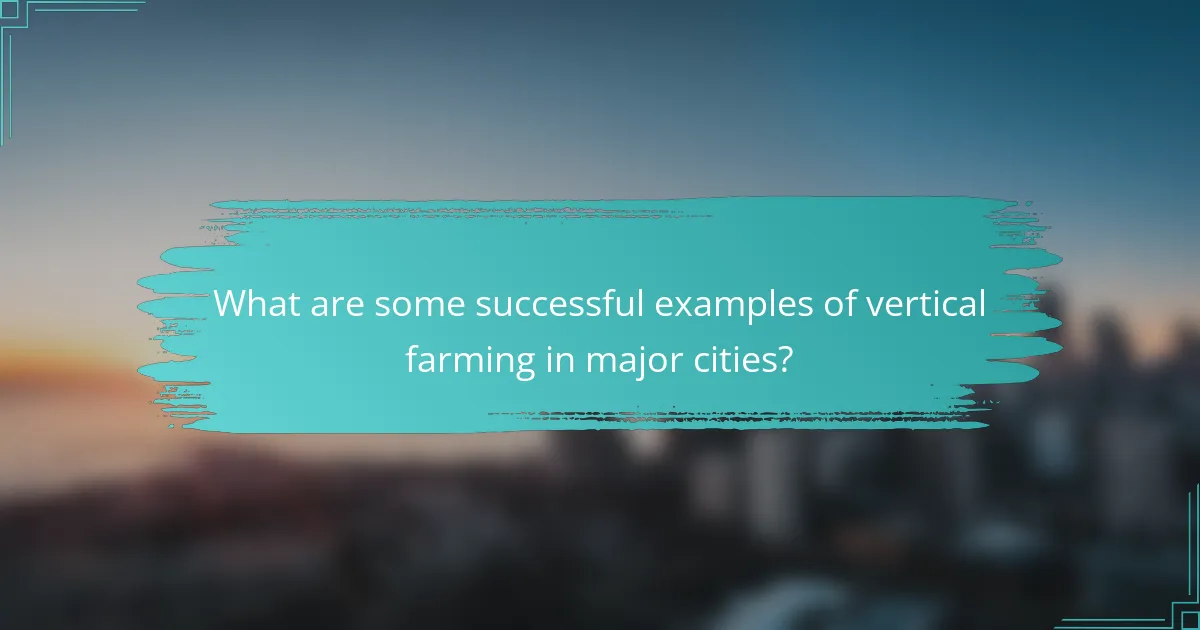
What are some successful examples of vertical farming in major cities?
Successful vertical farming initiatives in major cities demonstrate innovative approaches to urban agriculture, enhancing food security and sustainability. Notable examples include farms in New York City, Singapore, and Tokyo, each employing unique technologies and strategies to maximize space and resources.
New York City
In New York City, vertical farms like Bowery Farming and Gotham Greens are leading the way. These farms utilize hydroponic systems to grow leafy greens and herbs in controlled environments, reducing the need for pesticides and minimizing water usage by up to 90% compared to traditional farming.
Bowery Farming, for instance, operates multiple farms across the city, supplying local restaurants and grocery stores with fresh produce year-round. Their use of data analytics and automation enhances efficiency and crop yield, making urban farming more viable.
Singapore
Singapore has embraced vertical farming as part of its strategy to achieve food security. With limited land, farms like Sky Greens and Comcrop utilize vertical structures to grow vegetables and fruits. These farms often incorporate renewable energy sources, such as solar panels, to power their operations.
Sky Greens employs a unique rotating vertical system that allows plants to receive optimal sunlight while conserving water. This innovative approach not only maximizes space but also aligns with Singapore’s sustainability goals, aiming to produce 30% of its nutritional needs locally by 2030.
Tokyo
Tokyo’s vertical farming scene is characterized by high-tech facilities like Spread, which focuses on automated production of lettuce. Spread’s farm is equipped with advanced robotics and AI to monitor plant growth, ensuring consistent quality and reducing labor costs.
The farm’s efficiency is evident, as it can produce tens of thousands of heads of lettuce daily while using significantly less water and energy than traditional farms. Tokyo’s commitment to integrating technology into agriculture reflects its broader urban sustainability initiatives.
